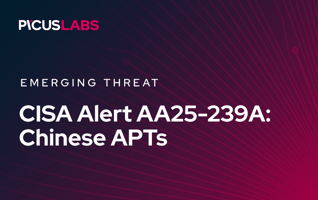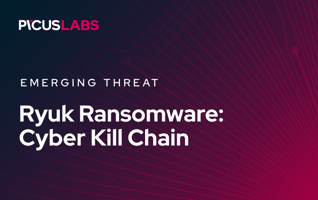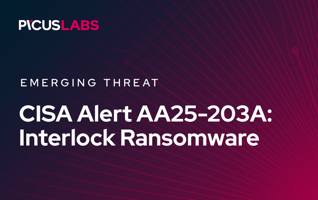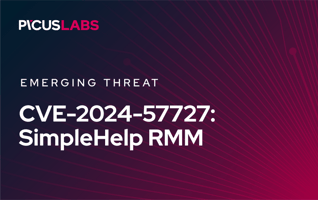How to Beat Nefilim Ransomware Attacks
A Detailed Walkthrough of Nefilim Ransomware TTPs
Over the course of 2020, the number of ransomware attacks has increased enormously. As an emerging ransomware family, Nefilim has caused dozens of high profile breaches since March 2020. In this blog post, we provide tactics, techniques and procedures (TTPs) utilized by the Nefilim threat actors, since detecting and blocking TTPs used by a threat is the most effective method to prevent that threat. TTPs allow us to detect potential intrusions and analyze the behavior of those attempting to intrude.
Our analysis uses the MITRE Adversarial Tactics, Techniques, and Common Knowledge (ATT&CK®) version 8 framework. See the ATT&CK for Enterprise version 8.1 for all referenced threat actor tactics and techniques.
This blog describes:
- TTPs used by the Nefilim ransomware, categorized under MITRE ATT&CK tactics and techniques.
- An example threat in the Picus Threat Library that can be used to simulate the TTP.
- An example mitigation rule in the Picus Mitigation Library that can be used to prevent/detect the given TTP.
-
Initial Access
Adversaries use Initial Access techniques to gain a foothold in the target network.
1.1 MITRE ATT&CK T1190 Exploit Public-Facing Application
Nefilim operators exploit public-facing applications for initial access. They mainly use the CVE-2019-19781 Remote Code Execution vulnerability affecting Citrix ADC/Gateway. Picus Threat Library includes 600+ vulnerability exploitation threats associated with the relevant CVE (Common Vulnerabilities and Exposures) identification number.
Following threats in the Picus Threat Library can be used to simulate this TTP:
|
Threat ID |
Threat Name |
|
321318 |
Citrix Application Delivery Controller (ADC) and Gateway Path Traversal Vulnerability Variant-1 |
|
311195 |
Citrix Application Delivery Controller (ADC) and Gateway Path Traversal Vulnerability Variant-2 |
Following mitigation signatures can be used to prevent CVE-2019-19781 exploitation:
|
Security Product |
Signature ID |
Signature Name |
|
Check Point NGFW |
asm_dynamic_prop_CVE_2019_19781 |
Citrix Multiple Products Directory Traversal (CVE-2019-19781) |
|
Cisco Firepower NGFW |
1.52512.2, 1.52603.1 |
SERVER-WEBAPP Citrix ADC and Gateway arbitrary code execution attempt |
|
F5 BIG-IP |
200004998 |
Citrix NetScaler NSC_USER Remote Code Execution |
|
Forcepoint NGFW |
HTTP_CRL-Citrix-Path-Traversal-CVE-2019-19781 |
|
|
FortiGate IPS |
48653 |
Citrix.Application.Delivery.Controller.VPNs.Directory.Traversal |
|
FortiWeb WAF |
090501033 |
Known Exploits |
|
McAfee NSP |
0x45272800 |
HTTP: Citrix ADC Arbitrary Code Execution Vulnerability (CVE-2019-19781) |
|
Palo Alto Networks NGFW |
57497 |
Citrix Application Delivery Controller And Gateway Directory Traversal Vulnerability |
|
TippingPoint TPS |
36876 |
HTTP: Citrix Application Delivery Controller (ADC) Directory Traversal Vulnerability |
-
Execution
2.1 MITRE ATT&CK T1106 Native API
Nefilim directly interacts with the native OS application programming interface (API) to execute behaviors.
|
Picus Threat Library - Threat |
Picus Mitigation Library - Detection Rule |
|
338852 Execution through API Attack Scenario |
8418 New Process Creation via CreateProcess API Call |
-
Defense Evasion
3.1 MITRE ATT&CK T1055 Process Injection
The Nefilim ransomware creates a new wermgr.exe (the Windows error reporting manager) process and injects its payload to evade process-based defenses. You can read our process injection blog post for a detailed description of this method.
|
Picus Threat Library - Threat |
Picus Mitigation Library - Detection Rule |
|
481103 Process Injection Attack Scenario |
6443 Reflective Portable Executable Injection |
3.2 MITRE ATT&CK T1574.002 Hijack Execution Flow: DLL Side-Loading
Nefilim uses WerFault.exe and wermgr.exe for DLL Side Loading, a defense evasion technique used by adversaries to execute malicious payloads by hijacking the library manifest used to load DLLs. Werfault.exe is the Windows Error Reporting binary used by many different programs to report errors.
|
Picus Threat Library - Threat |
Picus Mitigation Library - Detection Rule |
|
286264 DLL Side-Loading by using Xwizard.exe |
6042 Arbitrary DLL Load |
3.3 MITRE ATT&CK T1562.001 Impair Defenses: Disable or Modify Tools
The Nefilim ransomware uses a batch file to stop services and kill processes in the local host. This batch file abuses taskill.exe using CMD to kill predefined services and processes in the target host. Nefilim distributes this batch file to multiple hosts using two batch files. One of the batch files uses the ‘copy’ command, and the other one uses WMI with hard-coded admin credentials.
|
Picus Threat Library - Threat |
Picus Mitigation Library - Detection Rule |
|
650331 Stop Service Attack Scenario |
8863 Critical Services Termination with TaskKill Tool |
3.4 MITRE ATT&CK T1070.004 Indicator Removal on Host: File Deletion
Nefilim removes itself from the target systems after infection with the following code:
|
del "C:\Users\admin\AppData\Local\Temp\<ransomware_file_name>.exe" /s /f /q |
|
Picus Threat Library - Threat |
Picus Mitigation Library - Detection Rule |
|
681453 Indicator Removal on Host Attack Scenario |
6467 Defense Evasion by Windows Security Event Log Deletion |
3.5 MITRE ATT&CK T1497.003 Virtualization/Sandbox Evasion: Time Based Evasion
Nefilim uses the following ‘timeout’ command to delay the execution of the ‘del’ command. Adversaries use this command also to evade sandbox analysis.
|
"C:\Windows\System32\cmd.exe" /c timeout /t 3 /nobreak |
|
Picus Threat Library - Threat |
Picus Mitigation Library - Detection Rule |
|
744943 Virtualization/Sandbox Evasion by using Timeout Command in Command-Line Tool |
2313 Sandbox Evasion by Pausing The Command Processor via Timeout Command |
-
Credential Access
Nefilim threat actor uses hard-coded admin credentials to utilize PsExec and WMI to execute commands and binaries in remote hosts (lateral movement). Since these credentials are hard-coded in the batch files, it must be stolen before the attack with some credential access techniques.
4.1. MITRE ATT&CK T1056.001 Input Capture: Keylogging
The Nefilim ransomware creates a DirectInput object using the DirectDrawCreateEx function to capture keystrokes.
|
Picus Threat Library - Threat |
Picus Mitigation Library - Detection Rule |
|
431235 Input Capture Attack Scenario |
5924 User Input Capture via PowerShell Script |
4.2 MITRE ATT&CK T1003 OS Credential Dumping
Nefilim uses the Mimikatz tool to obtain username and password information useful in gaining access to additional systems in the target network.
|
Picus Threat Library - Threat |
Picus Mitigation Library - Detection Rule |
|
393510 Credential Dumping using Mimikatz Tool |
4920 Password and Hash Dump via Mimikatz |
-
Discovery
Interestingly, the batch files used by Nefilim include hard-coded Internal IP addresses, admin credentials, services, and processes. This means that Nefilim attacks are highly targeted attacks as the hard-coded information requires an intensive discovery operation prior to attacks. Dynamic analysis of the Nefilim ransomware samples shows that the following techniques are used by Nefilim to discover the required information.
5.1 MITRE ATT&CK T1518.001 Software Discovery: Security Software Discovery
The Nefilim ransomware uses IsDebuggerPresent, CheckRemoteDebuggerPresent, and NtQueryInformationProcess API functions to check if a user-mode debugger is running. Debuggers are used by security analysts to inspect malware’s behavior at the run-time. In the presence of a debugger, malware samples exhibited less malicious behavior. Moreover, Nefilim uses the NtSetInformationThread API function to evade debugging.
|
Picus Threat Library - Threat |
Picus Mitigation Library - Detection Rule |
|
112771 Security Software Discovery Attack Scenario |
3379 Security Software Discovery |
5.2 MITRE ATT&CK T1018 Remote System Discovery
Nefilim reads the hosts file (C:\Windows\System32\drivers\etc\hosts) to get a listing of other systems by IP addresses and hostnames on the network that may be used for Lateral Movement from the current system.
|
Picus Threat Library - Threat |
Picus Mitigation Library - Detection Rule |
|
101233 Gather Windows Host File |
6813 Remote System Discovery by Obtaining Mappings of IP Addresses to Host Names |
5.3 MITRE ATT&CK T1082 System Information Discovery
The Nefilim ransomware queries volume information (disk volume name and serial number) and Cryptographic Machine GUID. Ransomware families use Cryptographic Machine GUID and volume serial number to generate a unique identifier for the host for encryption/decryption processes.
Nefilim obtains Cryptographic Machine GUID by querying the value of MachineGuid in the following Registry key:
|
HKEY_LOCAL_MACHINE\SOFTWARE\Microsoft\Cryptography |
|
Picus Threat Library - Threat |
Picus Mitigation Library - Detection Rule |
|
793307 Query Cryptographic Machine GUID in Registry |
6886 System Information Discovery via Querying MachineGuid Key Value in Registry |
5.4 MITRE ATT&CK T1083 File and Directory Discovery
Like a typical ransomware TTP, Nefilim enumerates files before encrypting them. It uses some FileAPI functions such as FindFirstFileW, lstrcmpiW and FindNextFileW to discover files.
|
Picus Threat Library - Threat |
Picus Mitigation Library - Detection Rule |
|
286738 File and Directory Discovery Attack Scenario |
4771 Sensitive Information Discovery by Searching Filenames |
-
Lateral Movement
Lateral Movement refers to a tactic that adversaries use to move through a network to access and control remote assets in the network. To accomplish Lateral Movement, adversaries may use legitimate tools with valid accounts as well as their remote access tools.
6.1. MITRE ATT&CK T1570 Lateral Tool Transfer
The Nefilim ransomware downloads the Psexec.exe tool, and it also abuses the Windows built-in WMI (Windows Management Instrumentation) utility for lateral movement. PsExec is a free Microsoft tool that can be used to execute commands and binaries on remote systems and download or upload a file over a network share. Nefilim uses PsExec and WMI with hard-coded admin credentials to remotely execute the batch files and the ransomware file in remote hosts.
|
Picus Threat Library - Threat |
Picus Mitigation Library - Detection Rule |
|
526471 Remote File Encryption with PsExec |
3244 PsExec Tool Remote Command Execution |
-
Collection
Adversaries use the techniques in the Collection tactic to gather information relevant to their objectives. Various data types such as text, audio, and video are collected from multiple sources such as local system cloud, network drive, removable media, and clipboard. The next goal after data collection is often to exfiltrate the data.
7.1 MITRE ATT&CK T1056.001 Input Capture: Keylogging
The Nefilim ransomware creates a DirectInput object using the DirectDrawCreateEx function to capture keystrokes. Keylogging is both a Credential Access and Collection tactic.
|
Picus Threat Library - Threat |
Picus Mitigation Library - Detection Rule |
|
431235 Input Capture Attack Scenario |
5924 User Input Capture via PowerShell Script |
-
Exfiltration
Adversaries use techniques in the Exfiltration tactic to steal data from your network. They encrypt or compress the data to be exfiltrated and use different channels and protocols to avoid detection. For example, the Nefilim ransomware compresses collected files and exfiltrates them to cloud storage.
Data loss protection is one of the top priority issues for CISOs today. Organizations utilize DLP solutions to protect and secure their data and comply with regulations. Picus simulates the exfiltration of a wide range of data over different channels to test the effectiveness of both network and endpoint-based data loss prevention (DLP) solutions. Picus Threat Library includes hundreds of data files consisting of different types of information mapped to standards and regulations, including PII, PCI DSS, PHI, GDPR, HIPAA, PIPEDA, confidential files such as password files of OSs, and Intellectual Property (IP) data.
Some examples of data exfiltration attacks in the Picus Threat Library are given in the following table:
|
Picus Threat Library - Threat |
|
|
107307 |
Italy PCI and PII Information Exfiltration including Full Credit Card Info |
|
893939 |
Italy PII Info. Exfiltration including Codice Fiscale |
|
727983 |
IBAN Numbers of 100 Countries Exfiltration in XLSX Format |
8.1 MITRE ATT&CK T1567.002 Exfiltration Over Web Service: Exfiltration to Cloud Storage
Nefilim operators use the MEGAsync application to exfiltrate data to cloud storage. MEGAsync application synchronizes folders between the infected computer and an adversary-controlled MEGA Cloud Drive.
-
Impact
The Impact tactic covers techniques that manipulate, interrupt, or destroy your systems to disrupt availability, compromise integrity, or cover a confidentiality breach.
9.1 MITRE ATT&CK T1486 Data Encrypted for Impact
Like other ransomware threats, Nefilim encrypts files on the target system using AES-128 and adds NEFILIM, NEPHILIM, MERIN, TRAPGET, MEFILIN, TELEGRAM, SIGARETA, or OFFWHITE extension to encrypted files. It uses an RSA-2048 public key embedded in the ransomware executable to encrypt the AES encryption key. It also adds a file that includes the ransom note to the root directory, such as C:\NEFILIM-DECRYPT.txt.

Nefilim abuses Microsoft's Enhanced Cryptographic Provider to import cryptographic keys and encrypt data with API functions such as CryptImportKey, CryptAcquireContext, CryptCreateHash, CryptHashData, CryptDeriveKey, CryptReleaseContext, CryptDestroyKey, CryptEncrypt .This behavior is a very specific TTP of ransomware.
|
Picus Threat Library - Threat |
Picus Mitigation Library - Detection Rule |
|
767981 File Encryption with PowerShell |
4737 Cryptography Encryptor and Decryptor Utilization via PowerShell |
9.2 MITRE ATT&CK T1490 Inhibit System Recovery
Deleting volume shadow copies is very typical behavior of ransomware. The Nefilim ransomware uses WMIC with the following command to delete all volume shadow copies on the system to prevent recovery. WMIC is a command-line utility to access WMI.
|
wmic shadowcopy delete |
Nefilim also uses bcdedit.exe twice to disable automatic Windows recovery features by modifying boot configuration data.
|
bcdedit /set {default} recoveryenabled No |
Moreover, the Nefilim ransomware uses wbadmin to delete the backup catalog:
|
wbadmin delete catalog -quiet |
|
Picus Threat Library - Threat |
Picus Mitigation Library - Detection Rule |
|
205796 Inhibit System Recovery by Deleting All Volume Shadow Copies with WMIC |
7087 Shadow Copy Deletion via WMIC Tool |
|
562990 Inhibit System Recovery by Disable Automatic Windows Recovery Features with bcdedit |
3165 Disabling Windows Recovery Features via Bcdedit Tool |
|
407822 Inhibit System Recovery by Deleting Windows Backup Catalog with Vbadmin |
7067 Deleting Windows Backup Catalog via Vbadmin tool |
Nefilim TTP Map
TTP Map of Nefilim that is created with TTPs detected from dozens of Nefilim ransomware samples can be found in the table below.
Although these TTPs are determined from the Nefilim samples, they are common in most ransomware families. The red techniques are very specific ransomware TTPs.
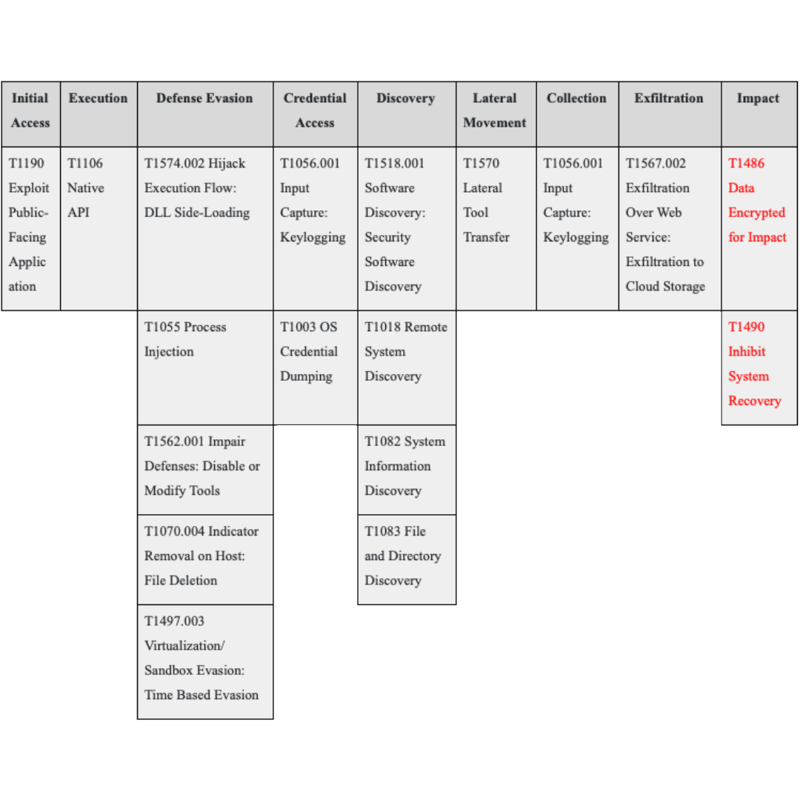
Conclusion
We analyzed dozens of Nefilim ransomware samples to determine tactics, techniques and procedures (TTPs) utilized by Nefilim. Continuously monitoring adversary TTPs within a company’s IT system allows companies to discover adversary behaviors and stop them before they can go any further. Picus emulates adversary TTPs and gives actionable mitigation information for each TTP for building a proactive defense against adversaries and their malware.

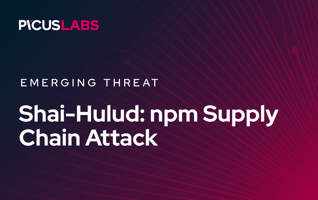
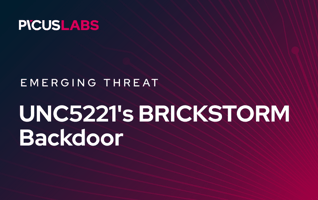
.png?width=353&height=200&name=Ivanti-EPMM-ET-preview-sept25%20(1).png)
